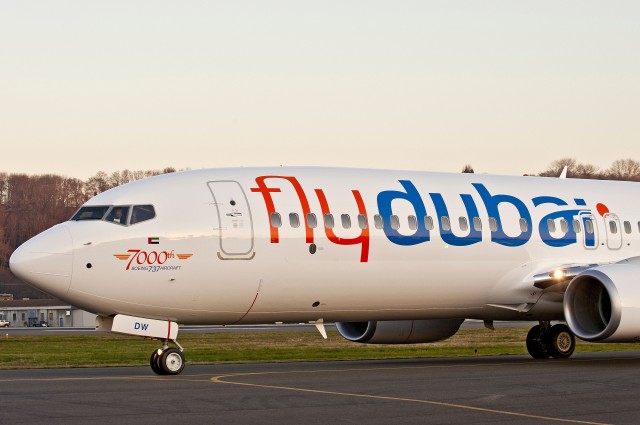
HI-RES PHOTO (click for larger). On December 16th, Boeing delivered their 7000th 737 to flydubai. The airplane is flydubai’s 14th Next-Generation 737-800 with the new Boeing Sky Interior. Photo by Boeing.
On Friday I posed the question, “How many Boeing 737s are still flying today,” and I received a lot of responses. So what is the answer? (insert drum roll here)…
… did you click that drum roll link? It really adds to the suspense. If you did not do it before, it is not too late…
According to Boeing, there are 5,424 737s still flying today with 358 airlines in 114 countries. Knowing that the first 737 flew on April 9, 1967, that is AMAZING! So, who were the three that got the closest and are winning a free internet session with GoGo In-Flight Internet?
* Thibaut: 5418
* Allen Cheng: 5419
* Will Pestle 5423 (only one away)
Some of you just guessed random numbers (which works out okay) and others went through some pretty impressive formulas. I was amazing how many people were pretty close to the final answers. A big thanks go GoGo for providing three prizes for this contest!
As promised, here are some other great facts about the 737 that come directly from Boeing:
* Today’s 737s are 5 percent more fuel efficient than the first models delivered. By late-2012, the airplanes will be a full 7 percent more efficient, with full incorporation of the latest performance improvement package. The additional 2 percent equates to $120,000 savings per airplane per year, and tons fewer carbon emissions.
* It was just shy of 15 years between the first Next-Generation 737 order and the 5,000th order. The Next-Generation 737 reached this order milestone more quickly than any other commercial jet in history.
* Airlines ordered 724 of the Next-Generation 737 models between the Next-Generation program launch Nov. 17, 1993, and the day the first airplane was delivered on Dec. 12, 1997.
* The Next-Generation 737 is as long as it is wide, earning it the nickname of the first ’œsquare’ airplane.
* The Next-Generation 737 uses an advanced system called Head-up Display or HUD, which comprises a transparent glass display positioned between the pilot’s eye and flight deck window to show critical information such as airspeed, altitude and attitude, and flight path. The Next-Generation 737 is the leader of large commercial jetliners produced today with this capability. Boeing is proud to introduce HUD as part of its basic systems equipment for both pilots on our 787.
* The Next-Generation 737 airplane wing thermal anti-ice system has the capability of outputting hot air on the wing leading edge equivalent to about six full-sized (100,000 BTU) household furnaces.
* Within five years of entering service, the worldwide fleet of Next-Generation 737s surpassed 10 million flight hours, a feat equal to one airplane flying more than 1,141 years nonstop. The Next-Generation 737 is the first and only commercial jetliner to reach this milestone so quickly.
* On July 27, 2006, Boeing delivered the 2,000th Next-Generation 737 six years sooner than any other commercial jet airplane. The milestone delivery ’“ a 737-700 to Southwest Airlines ’“ occurred nine years after Southwest received the first Next-Generation 737.
* There are approximately 36.6 miles (59 kilometers) of wire on the Next-Generation 737-600/-700/-800/-900ER (extended range) models, four miles (6.4 kilometers) less than the 737-300/-400/-500 models.
* On average, there are approximately 367,000 parts on a Next-Generation 737 airplane.
* Overall, the entire 737 family is the best-selling commercial jet in history, with orders for more than 9,100 airplanes through the end of November 2011. More than 6,900 have been delivered.
* On Feb. 13, 2006, Boeing delivered the 5,000th 737 to Southwest Airlines. Guinness World Records acknowledged the 737 as the most-produced large commercial jet airplane in aviation history.
* Typically, about 50 gallons (189 liters) of paint are used to paint an average 737. Once the paint is dry, it will weigh approximately 250 pounds (113 kilograms) per airplane, depending on the paint scheme.
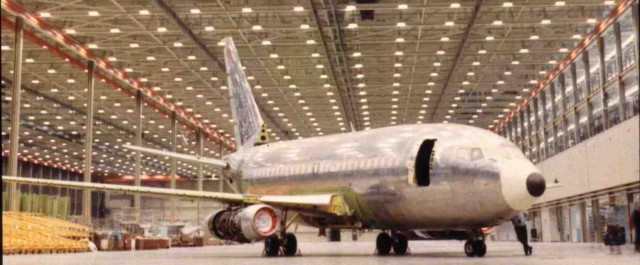
The first Boeing 737, which does not have GoGo Internet. Photo found via Gordon Werner / Flickr.
NOTE: The contest is now over. You can view the answer here.
Today, Boeing delivered their 7,000th 737 to FlyDubai — those are a lot of airplanes.
To celebrate this monumental achievement I feel like holding a contest. I was asked by a reader (thanks Robert G), “How many 737s out of the 7000 are still flying,” and that is a great question. I turned that question over to Boeing and have received an official answer that I am using for the contest. I also sent out a few “crack-team information finders” (thanks Dan and Ben) to see if there would be some website that would easily give the answer away (that happened during my last contest) and I feel confident this one is not easy.
Now, I am turning that question over to you: How many Boeing 737s are still flying today? (according to the official answer that Boeing gave to me on 12/15/11 – Note that although Boeing gave me the answer for the contest, they are no way involved with the contest)
Oh and there are some real prizes to go along with this one. GoGo Inflight Internet has agreed to give the three closest guesses a free internet session for their next flight (which makes a great stocking stuffer — for yourself).
So send me an email (da***@*************er.com) or leave a comment with your best guess (you only get one). You have until the end of the day Monday the 19th to guess and then I will reveal the answer with all sorts of other great facts about the legendary Boeing 737.
Game on.
We had taken off from Seattle a day before and had mini-adventures while in Iceland and Turkey. Now RwandAir’s first Boeing 737-800 was on her final leg to Kigali, Rwanda with only about 5.5 hours to go. In Part 1 I talked about pre-departure, then covered what it was like flying from Seattle to Iceland to Turkey in Part 2. In Part 3 I talk about what it was like finally arriving in Kigali to an amazing welcome.
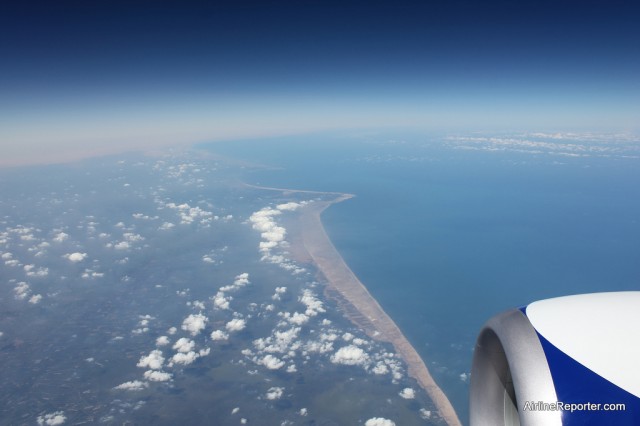
Heading into African airspace on our way to Kigali, Rwanda.
Before the 20hr flight I was concerned about the comfort level of a domestic Boeing 737. I was also afraid of having too much free time on my hands, so I brought a book, downloaded a lot of airline articles and even got some additional games for my iPhone. However, with sleep, socializing and watching 30 minutes of Big Mama 3 (I can’t believe I lasted that long), I did not get bored. It was comfortable having an entire row to myself, but I am sure my tone would have been different if I had shared my row with seat-mates. The back of the plane seemed the place to go if you were looking to get some sleep. Quite a few folks sitting up front made their way to their own rows in economy to stretch and rest.
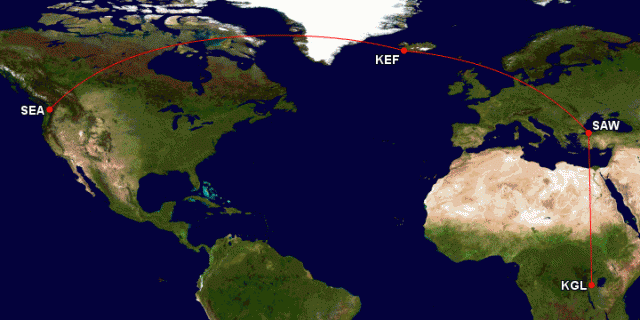
9,200 miles of adventure. Our route to Kigali.
I had used my electronics quite a bit from Seattle to Iceland to Istanbul. By the time we were on our final leg, they were badly in need of some power. I had forgotten my international power adapter and did not get to charge while in Turkey (luckily someone let me borrow theirs while in Rwanda — thanks Adam). Unfortunately the seats in the back of the plane did not have power outlets, but those in Business class did. I had three different devices plugged into three different seats up front. It was important I was all ready to go when touching down in Rwanda.
While my electronic distractions were charging,I had no problem gazing out the window. The sky was clear, so it was easy to witness crossing over to African airspace. It was interesting seeing desert forever, then civilization and green around water. We followed the Nile for a while and it really became clear how a river or water source really creates growth.
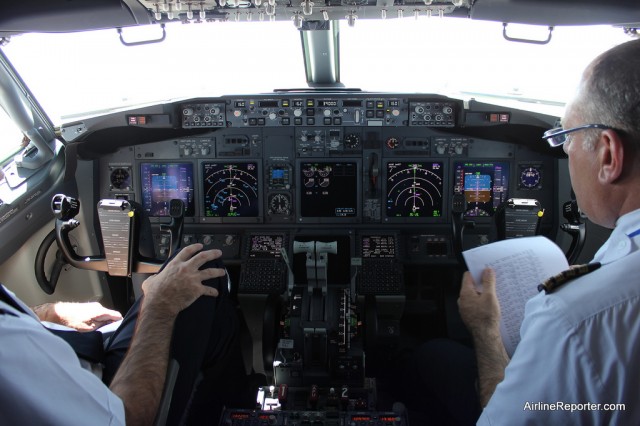
Hanging out in the cockpit of RwandAir's Boeing 737-800 while over Africa.
Although socializing and watching movies can be entertaining, the best form of entertainment is being in the cockpit. Even though my devices weren’t fully charged, I didn’t want to turn down an opportunity to visit the front of the plane while cruising at 39,000 feet to take photos, video and talk to the pilots.
Both pilots at the time had come from the now defunct Olympic Airlines and were very excited about flying the 737-800 — almost to the point of being giddy. They said it was an obvious improvement in performance, ease of use and efficiency. It sounded like there would be a formidable (and friendly) competition to see which pilots would get to fly the new 737-800 vs the older 737-500s in the fleet.
Every time I got up into the cockpit during flight, the calm always surprised me. I don’t know what I really expeced. Maybe the pilots constantly at the controls, talking on the radio, messing with knobs. But during cruise with a modern airliner, they are able to easily take time to enjoy flight. Looking straight out the front windscreen into the limitless blue makes the aircraft feel like it is not even moving. It is a cool experience and it is unfortunate that it is rare for even media to get into the cockpit during flight (and this is only the second airline to allow me to share photos).
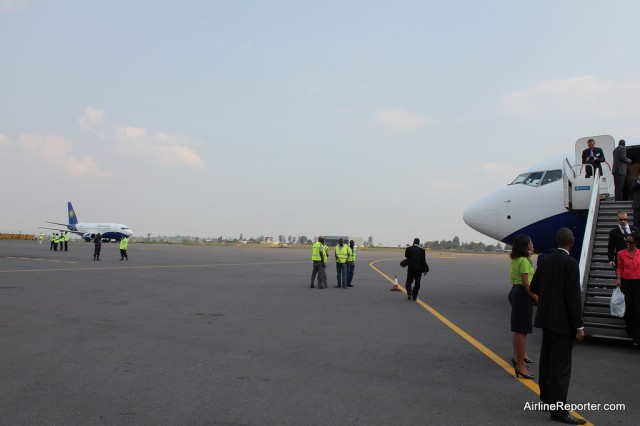
RwandAir's Boeing 737-500 looks on.
Before we knew it, the plane was starting its descent and we were almost done with our flying adventure. From the hotel to boarding the plane, most of us dressed up. But once on board, we changed into something more comfortable. Now realizing we were getting close to Kigali, it was time to get back into professional wardrobe. You would have thought with only 30 people on board, there wouldn’t be any lavatory issues, but when so many are trying to change and brush teeth at the same time, it really caused some issues. Ichanged my shirt in the aisle and brushed my teeth in a lavatory being used to store drinks. A guy has gotta do what a guy’s gotta do. Luckily everyone was ready to go and seated by the time we were flying low over Kigali.
We were told we would do a low fly over the airport before circling around to land. As we kept getting lower and lower, some of us became certain that the fly-by was cancelled and we were going to land. Kudos to the pilot since we buzzed the tarmac just a few feet off the ground before pulling up, circling around and landing.
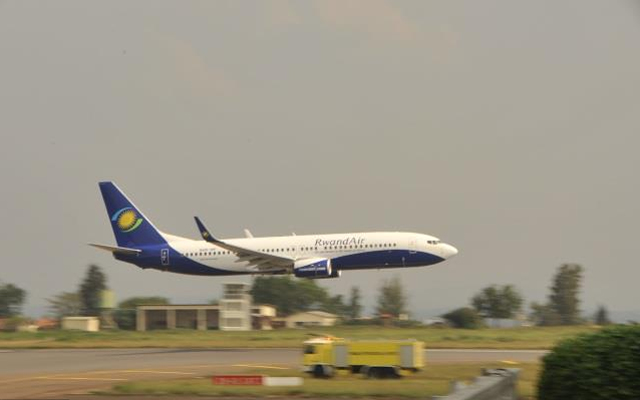
Our flight buzzed the airport before coming in for a landing. That is one nice fly-by. Photo from RwandAir.
People on board the airplane cheered as we landed and taxied to the tarmac. Two fire trucks gave us an official water salute as we pulled into the airport and before getting off the plane we could see a group of dancers starting to make their way out towards the plane.
It is hard to describe what it is like to be jet-lagged and stepping off a plane that just flew from Seattle to Rwanda with people dancing, music playing and people wanting to shake your hand. This was an amazing moment for almost everyone there and the most impressive welcome I have ever experienced.
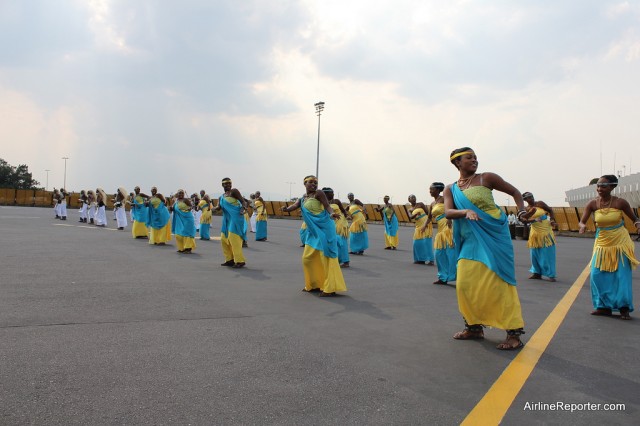
Upon landing we were greeted by dancers, local media and VIP guests.
After things calmed down, we headed through customs and over to a special tent where additional guests were seating. All the important dignitaries and the airline CEO spoke and talked about the importance of this proud achievement.
The plane was not just carrying people over to Africa. Boeing has a program called Humanitarian Delivery Flights that, “humanitarian items; such as, medical supplies, clothing, and educational materials, are loaded into the empty cargo space of new airplanes being delivered and transported to a customer’s home destination.” On this flight, there were 1500 educational books that were being delivered to the Rotary Club of Kigali to be distributed to high schools, universities and libraries around the country. Boeing partnered with RwandAir and Operation USA to help deliver the books and there were a group of children at the celebration to accept them.
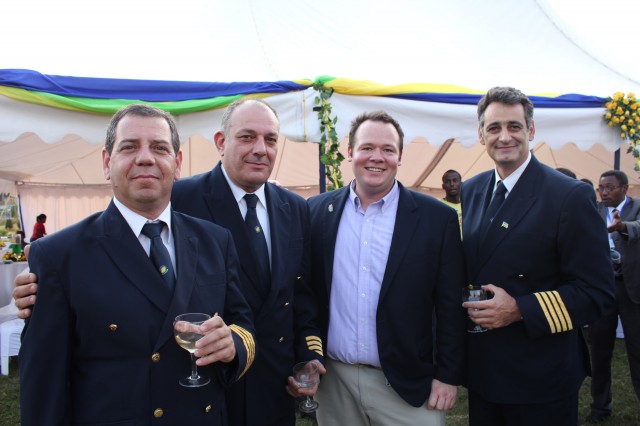
Some RwandAir pilots and me hanging during the post delivery reception.
We all had some food, drinks and great conversations, but after our long journey, it was time to head to the Kigali Serena Hotel. I was not quite sure what to expect of my accommodations when staying in Rwanda. For some reason I kept picturing a bed with a bug net and a generator providing electricity. It is my own fault for not being informed, but it was a nice surprise to find that the hotel was way beyond my expectations. They even offered free Wi-Fi internet which can be hard to find in many American hotels.
The hotel was one of many interesting experiences during my four day stay in Kigali. Stay tuned for my Destination Rwanda story coming soon, followed by a video documenting the delivery flight. Until then…
VIEW ALL 90 PHOTOS FROM THE TRIP TO KIGALI
RWANDAIR BOEING 737-700 DELIVERY FLIGHT
Part 1 | Part 2 | Part 3 | Video | 737 Photos | Rwanda Photos | Destination Story | All
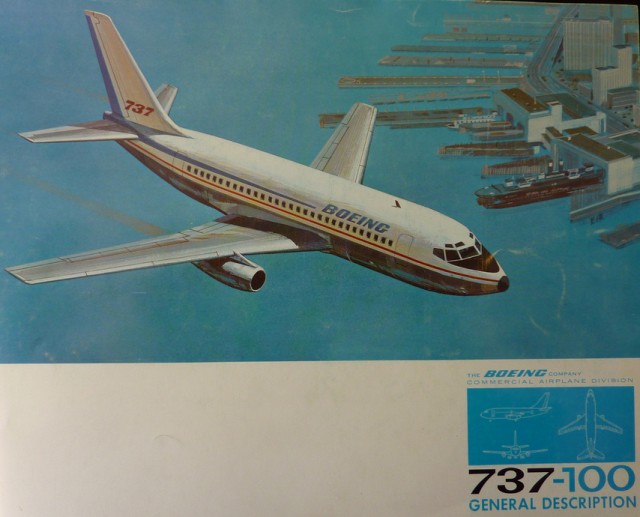
April 1965 Boeing Sales Brochure for the then soon to be Boeing 737-100 Airliner
The Boeing 737 is the best selling airliner ever built. With hindsight it is easy to see this was going to be a successful jet airliner, but at the time, Boeing already had the larger 707 and 727 and it was not certain that the 737 was going to be successful. Boeing felt there was a market for shorter routes to have jet service and airlines were looking to replace props. Boeing needed to sell the new 737 to airlines and in 1965 made a marketing brochure that I wanted to share. Lucky for us, Gordon Werner was able to get a hold of one of these books and put it up on Flickr. The brochure is 40 pages, but I wanted to share some gems.
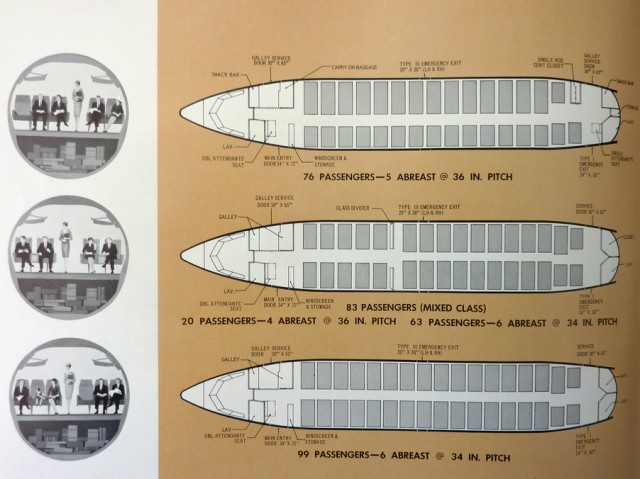
Boeing showed potential airline customers how they could configure the 737 in 6, 5 or 4 abreast seating.
Did you know that Boeing promoted the 737 as able to carry four, five and six abreast seating? Boeing was looking for an aircraft originally that could carry 50-60 passengers on routes from 50-1000 miles. Today, the 737 is capable of carrying 220 passengers (737-900ER) and go farther than 6,000 miles (737-700ER).
From the brochure, “Now, the 737 offers the public jet speed, comfort, and convenience on routes as short as 100 miles.”
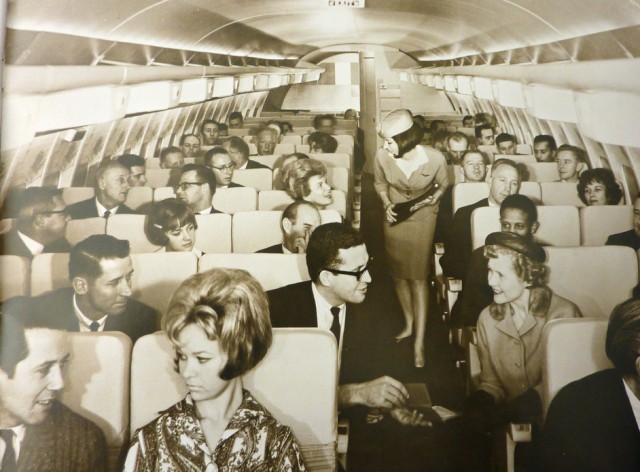
The 2-3 layout in this 737 mock up (I am assuming it is a mock up) shows how roomy the 737 could have been.
The 737-100 first rolled out on January 17, 1967 and was delivered to Lufthansa Airlines on December 28, 1967. This particular model was only built until 1973, but obviously other models are still being produced today. The Boeing 737 lineage will continue with the introduction of the new MAX variants.
The brochure states, “The 737 fills out Boeing’s family of jetliners specificaly designed to serve a variety of markets. In the mid-1950’s the popular 707 concentrated on the continental markt and longer routes with one stop. Later the 707-320 and -320B extended the nonstop range to 6000 miles… Now the 737 offers the public jet speed, comfort, and conveniene on routes as short as 100 miles. Fully certificated 737’s scheduled for delivery beginning in late 1967 offer attractive profit potentials. Boeing jets have proved profitable in the past. The 737 will pay off in the future.”
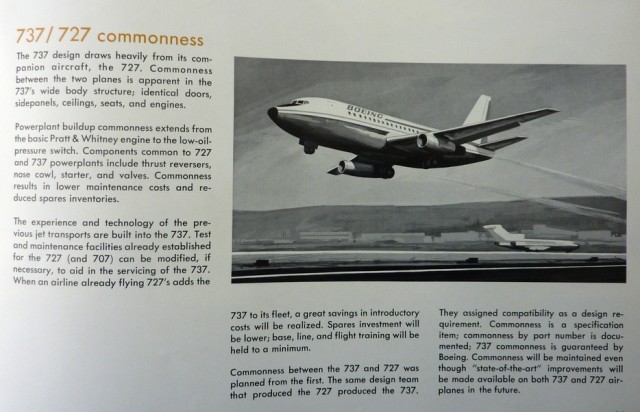
Boeing compares the 737 to the 727.
If you have some time to burn today, make sure to look through each of the 40 pages on the Boeing 737-100 brochure and share some of the more interesting things you find in the comments. A big thanks to Gordon for putting these online and allowing me to share.
In Part 1, I discussed what it was like from pre-delivery of RwandAir’s first Boeing 737-800 to taking off from Seattle. Part 2 will cover our adventures from lift off to a stop over in Iceland and Turkey. Here is Part 2:
The Boeing 737-800 normally has a range of about 3000 miles with an average load, but this was not an average flight. With only 30 people on board, the aircraft was much lighter which allowed us to fly over 3,600 miles non-stop from Boeing Field in Seattle, WA to Keflavik (KEF) just outside of Reykjavik, Iceland.
I had the entire 14th row to myself, and rows 13 and 15 were totally empty. I felt like a king sitting in economy, which doesn’t happen too often. Though I had ample space, there were some disadvantages to sitting in the back of the plane was the in-flight entertainment system. Business Class passengers got their own in-seat entertainment system, but it is all about sharing in the rear. After we took off and leveled out, the movie Cedar Rapids started playing, but I opted for a nap instead. I knew I wouldn’t have too much time to sleep since we were racing against the sun. Even though we took off at about 5:30pm, we were going to land in Iceland after it would be dark a little under seven hours later.
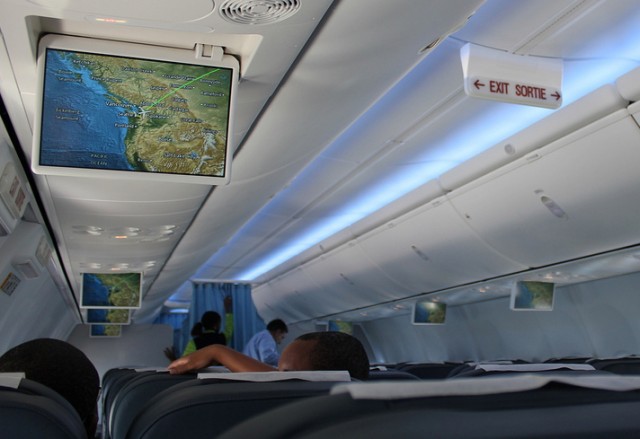
The in-flight map shows we just left Seattle. We have a long trip ahead of us.
Even with an entire row to myself, it still was not easy getting comfortable as a 6’1″, 250lb person. Still, I managed to sleep a few hours lying down and a few hours while sitting up. When I awoke, it was time to eat our first meal. Before the flight, food service was loaded onto the aircraft, and I was looking forward to (eh, more afraid of) what it might be. Fortunately, the food was better than your standard economy fare, consisting of a decent steak and shrimp.
At first, the service on the flight was a bit strange. Although there were only about 30 people on the aircraft, the flight attendants provided separate levels of service for business versus economy. I have been on a few VIP flights with a smaller number of passengers and service was the same in the front and back. At the start of this trip, the front got hot towels, champagne and first class service. Not that we were hurting in the back, but I wanted my hot towels and extra drinks (how spoiled I have become). It turns out the cabin crew just never thought about it was initiating the standard level of service they regularly complete. From Iceland on, the divider curtain was not shut and everyone received the same high level of service.
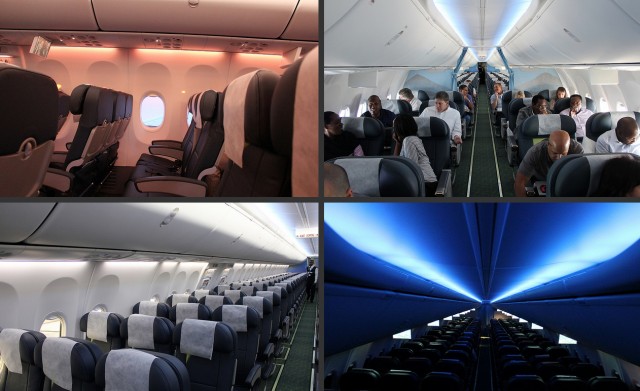
Some of the different flavors that Boeing's Sky Interior can produce. Upper left is meal service and bottom right is sleep. The others are standard operating settings.
Most passengers might not realize they are on a 737 with the new Sky Interior. But they should notice how modern and roomy the plane feels. After catching a ride on American Airline’s first Sky Interior 737 and now after about 20 hours in RwandAir’s, I can truly say I love it. It is not revolutionary, but a very smart evolution to the 737.
There are optical illusions and actual changes that make the cabin seem larger. The windows now have a round surround and updated paneling on the walls. The ceiling has color-changing LEDs and the standard setting is a nice blue, which makes the cabin feel taller. The overhead bins have been re-designed to be opened and closed more easily, while providing more head space for passengers. As of now, the Sky Interior is an option for airline customers and about 88% of airlines are opting for the new interior. Boeing has announced that all 737 MAX aircraft will come with the Sky Interior standard.
Because this was a longer flight, I was able to see a larger array of lighting choices. Airlines are able to choose different light settings for different parts of the flight: blue for boarding, white before landing, an orange while eating and maybe a deep blue for sleeping. But by the time we were getting close to Iceland, it was already quite light outside.
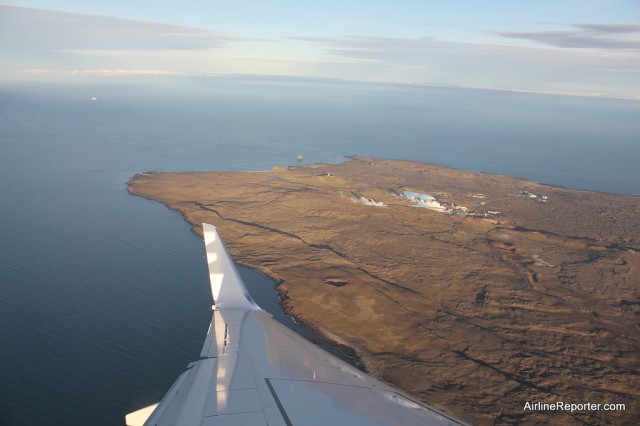
Coming into Iceland is quite bare. I wasn't sure we were actually landing at a main airport, but it was.
When finally breaking through the clouds outside of Iceland, I assumed it was going to be a while until we hit the airport since there was nothing but land in sight. Sure enough, the airport was in the middle of nowhere. When landing, I was hoping for some pretty heavy cross wind normally found at the airport, but on this cold morning there were only a few gusts. The airport is great if you love Icelandair Boeing 757s, since there were quite a few. We ended up parking next to the cargo loading area and waited to be fueled. We were allowed to leave the plane and hang out on the tarmac and even though it was nippy, I opted to spend almost the whole time out there.
After being fueled up and loaded back in, I noticed the special Iron Maiden livery Boeing 757 was behind us, providing a nice treat. Even the non-airline nerds on the plane found the livery interesting. Then was were back in the sky, heading south to Istanbul, Turkey.
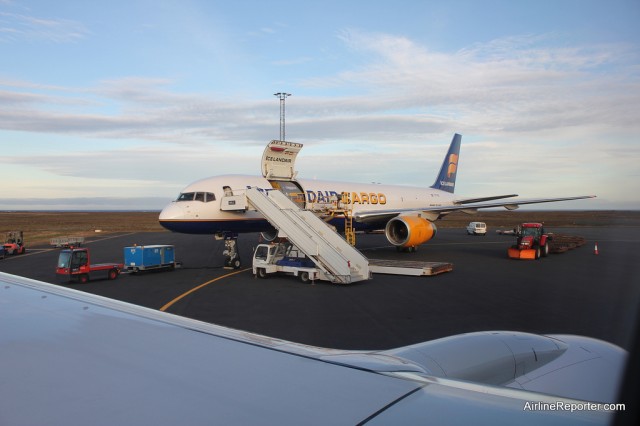
An Icelandair Cargo Boeing 757 looks on while we wait to be fueled. Lots of nothingness in the background.
We were supposed to land at Atatà¼rk International Airport (IST), but our late arrival meant, there were not any slots available during our new landing time. We landed instead at the much smaller Sabiha Gà¶kçen International Airport (SAW), which operates low cost carriers like Pegasus Airlines. This wasn’t a bad thing, since it allowed us to deplane on the tarmac, giving better photo opportunities.
After clearing through customs, we had a van waiting to take us to Divan Hotel. It was about 8pm local time when we arrived, but I knew I did not just want to eat and go to sleep. First things first; it was time to take a nice long cool shower and then prepare for a night-time adventure.
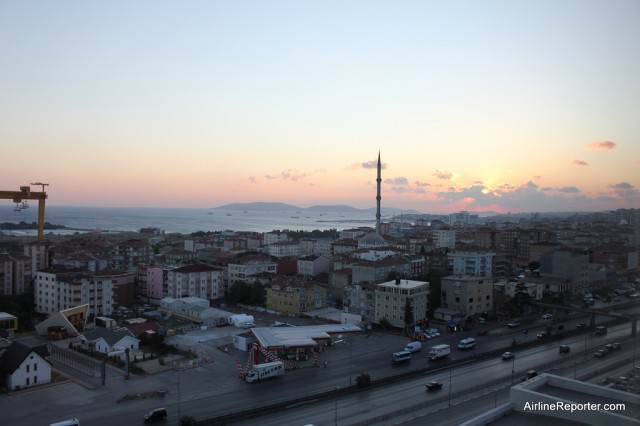
Not too shabby. View from my hotel room while in Istanbul, Turkey.
After cleaning up, most of our group met on the rooftop bar of the hotel. When I first arrived there were only four people including RwandAir’s CEO John Mirenge. He welcomed me to the table and offered food and drink and I asked him what it felt like to see his brand new plane for the first time. He stopped and it was obvious he was emotionally affected. It was not only about buying a new plane, but it was about being able to take the plane back to Rwanda. I have never seen an airline executive so connected to one of his aircraft — it was quite powerful.
After talking about airplanes, it was time to relax and have some local Efes Beer and some food. Even though it was late, most of us decided to head out into town. I was told we were on the Asian side of town, but there is also the European side of town as well. We got three cabs and honestly I have no idea where we went, but I was just along for the ride. After some coffee we decided to get some “adult” drinks and ended up at a bar called “The Sheriff” that was Old West themed. It took us a while to realize we had just flown half way around the world to go to a western bar — oh well. We were quite surprised that it happened to be so dead around midnight on a Friday. We asked some locals and learned it was Ramadan. Religious natives were not going out, which I can understand, but it made the night life more like a mid-week evening life.
After hanging out for a while, it was time to take a cab back to the hotel. Driving in Istanbul seems like every man for himself. At intersections, people do not yield and speed is the name of the game. During the taxi ride home I sat in the front seat and my belt did not work — it was quite the hairy ride. The driver had a hard time finding his way back to the hotel, and just decided to stop in the middle of the freeway where he pointed to stairs across the road that we could take. Obviously hospitality was not a concern of his.
It is difficult to judge an entire city by just spending 14 hours there, so I would love to return with some additional time and maybe a better taxi driver.
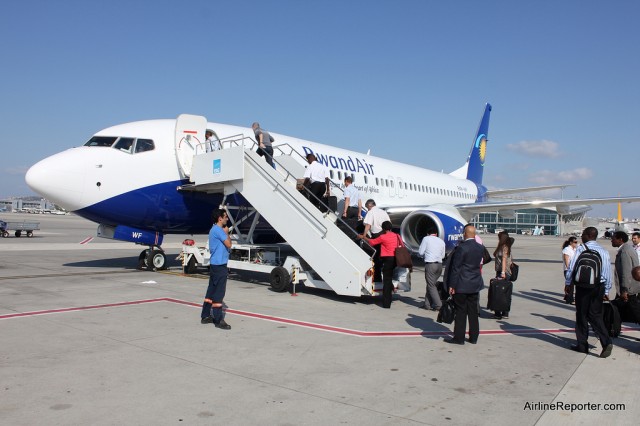
Loading back on the plane in Istanbul, getting ready to fly to Kigali, Rwanda.
After a short rest, we met up in the lobby of the hotel ready to continue our journey to Kigali. While heading back through the airport customs, the security official was shocked when he saw my boarding pass said “Kigali.” Because of a minor language barrier, it took me a while to realize he wasn’t questioning me for security purposes, but because of his own interest in the boarding passes he sees.
The RwandAir 737 was right where we left it. We quickly re-boarded and I decided to take a seat a bit closer to the front of the engines for better photos while landing. I already had quite a few assumptions about what Rwanda was going to be like and I was about to find out how wrong I was. We had about a five and a half hour flight down south and we heard we had quite a celebration waiting for us at our destination. I buckled up, sat back and was ready for the real adventure to begin.
RWANDAIR BOEING 737-700 DELIVERY FLIGHT
Part 1 | Part 2 | Part 3 | Video | 737 Photos | Rwanda Photos | Destination Story | All


















